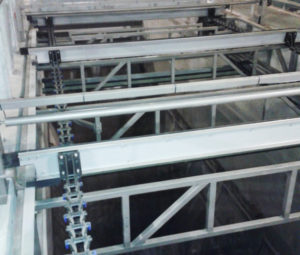
In this sponsored post, wastewater expert Jacopa details the completion of a £2.5m design and installation contract for a dissolved air flotation (DAF) solution on behalf of Dŵr Cymru Welsh Water’s landmark Swansea wastewater treatment plant.
The solution was provided for client Imtech Process on behalf of Dŵr Cymru Welsh Water.
One of Dŵr Cymru’s flagship plants, the Swansea works went into operation in 1996 as a “Zero Nuisance Plant”, designed to be buried underground with extensive landscaping to disguise its existence from the landward side.
The original facility treatment train consisted of screening, fat, oil, grease and grit (FOGG) removal lanes, primary settlement tanks (PSTs) fitted with lamella plates, a four-lane activated sludge process, final settlement tanks (FSTs) that are also fitted with lamella plates, and UV disinfection as well as sludge treatment. With a need to reduce operating costs and comply with the tightened effluent discharge consent for Swansea Bay, sustainable improvements were needed.
The works has therefore been undergoing a substantial upgrade since 2011 that has modernised many of its treatment systems. Developing innovative process solutions to meet the identified needs for improvements has been challenging because of the restricted underground site.
It was decided that to ensure long-term compliance, one key solution was to change the process from the current activated sludge plant with final lamella settlement to moving bed biofilm reactors (MBBRs), and dissolved air flotation (DAF).
Jacopa’s remit to convert 11 FSTs to DAFs faced several challenges, not least that the lamella tanks were underground with access and lifting operations severely hindered. The chosen solution involved designing a frame and chain scraper halfway along the tank, because flow velocities at the surface were calculated to be sufficient for the float sludge to reach the scraped section.
Installation within such a restricted headroom was achieved by devising a novel lifting gantry to install the equipment. Components were manufactured in sub–assemblies and were put together in situ with expert input from the company’s Chippenham office.
Project manager Graham Fife notes: “It was not an easy task – the tanks are colossal, two storeys deep. Installing the equipment safely was priority. With the aid of the bespoke lifting gantry system, the install was achieved.”
Another key challenge for the £2.5 million contract was the changeover methodology. Two tanks had to be changed at a time to ensure the processes continued to provide full treatment for Swansea’s wastewater.
The plant is now operational and is in compliance with the tightened consents. The 112,000m3/day, 225,000 PE DAF plant has to achieve an effluent total suspended solids (TSS) limit of 30mg/l on average throughout the year.



